How to Create AI Voice Over Videos using an API

In this tutorial, you'll learn how to create AI voiceover videos using ElevenLabs and Creatomate, all with just a single API request.
Text-to-speech APIs like AWS Polly, Google TTS, and Microsoft Azure have been around for a long time. But if you ask me, the output often sounded artificial, not like human speech at all. Listen to an example from AWS Polly and you'll see what I mean.
Fortunately, much has changed in the past year. AI voice generation took a big step forward, with ElevenLabs and OpenAI paving the way. In fact, AI-generated speech is getting so good that it's hard to tell the difference between a real voice actor and a computer-generated voice. Now check out this one generated by ElevenLabs:
It's a world of difference. Unlike old TTS services that sounded robotic and flat, ElevenLabs' text-to-speech AI is capable of generating speech that is rich in emotion, tone, and depth. Even better, ElevenLabs lets you fully customize the voice, so it's ideal whether you're trying to create a professional sounding voiceover, or a dynamic and engaging voice that's perfect for social media. You can even clone your own voice by uploading your own recordings.
This tutorial shows you how to make voice-over videos using ElevenLabs and Creatomate. Speech synthesizing will be done with ElevenLabs' API. The actual video will be generated with Creatomate's API, ultimately creating an entire voiceover clip as shown above, complete with images and animated captions.
Prerequisites
To follow along, you'll need a free account with Creatomate and ElevenLabs. You'll also need a way to interact with the API. Creatomate is just a simple REST API, so you can use any API tool, like cURL, Insomnia, or Postman. You can also use your favourite programming language to invoke the API. Node.js has the fetch module, PHP has the GuzzleHttp library, and Python has the requests package.
How to add a voice over to a video using an API?
Generating a voiceover video involves using ElevenLabs' AI for text-to-speech and Creatomate's video API. Both platforms provide a simple REST API that is easily integrated into your own applications or workflows.
We'll begin by setting up an AI-voice in ElevenLabs. Next, we'll create a voiceover template in Creatomate. In order to make that work, we'll connect Creatomate to ElevenLabs. Finally, we'll be able to generate the video by making an API request to Creatomate. During this process, Creatomate uses ElevenLabs to generate the voice, create the subtitles, and put it all together in a video – all with just a single API call.
It is as simple as that. Let's get started!
1. Set up ElevenLabs' text-to-speech API
Sign up for ElevenLabs or log in if you already have an account. To create an account, go to ElevenLabs.io, and click the Sign up button in the top right corner.
ElevenLabs provides several options for creating AI voice overs. To simplify this tutorial, we'll use an existing voice from their library. But if you prefer, you can also design a voice or clone your own voice.
Note: Another option is to go with one of the premade voices. You can listen to a sample under Speech Synthesis in your ElevenLabs dashboard.
Let's click Voices in your sidebar, then go to Library:

From the Voice Library, choose a voice you want to use for your voice over, then click the Add button:
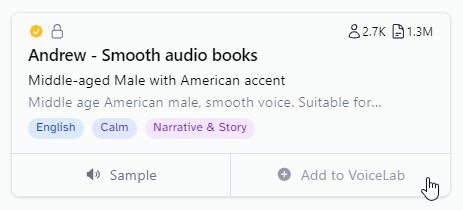
Return to the "My voices" page. Under the Community section, you'll see that the voice has been added. You can specify this voice by its ID, which will be used later in this tutorial. For now, click View, then click the ID button. Save the ID for future reference. (Click the screenshot to view it in full screen):
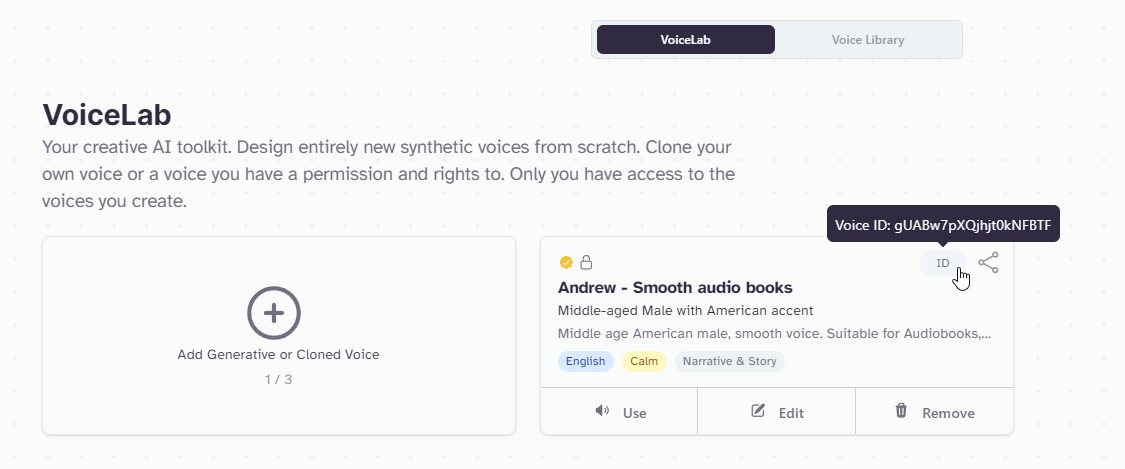
There is only one thing left to do in ElevenLabs before we can move forward. If you want to connect Creatomate to ElevenLabs, you'll need an API key. You can create one by clicking on My Account in the bottom left corner, and then click API Keys:
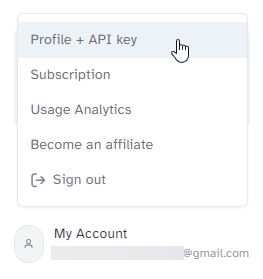
Let's move on to Creatomate.
2. Create a voiceover template
Log in to your Creatomate account or create a free account if you haven't already.
First, let's connect to our ElevenLabs account. To do so, click ... on the left, then choose Project Settings. Within the Integration section, toggle the switch to enable ElevenLabs. You'll then be prompted to enter your API key. Once you're done, click Confirm, and close the Project Settings:
Your ElevenLabs account is now connected to Creatomate. Next, we'll create a video template.
Navigate to the Templates page, and click the "New" button. For the purpose of this tutorial, go to the Voice Overs category, and click the Short-Form Voice Over template. Select the 9:16 Vertical size, then click "Create Template" to open it in the editor:
The video editor might seem intimidating at first, but don't worry – it's actually quite easy to get started.
If you're familiar with video editing, most of this will seem familiar. Creatomate's editor, designed for video automation, works a bit differently. It doesn't limit you to specific designs; nearly any type of video can be automated, giving you the freedom to implement your own custom ideas. Even the templates are open-source JSON, which can be generated through automation.
Let's focus on this voiceover template. You'll notice there are four compositions, each representing a scene in the video. Each composition includes a voiceover, subtitle, and image element. As you work with the template in the editor, you'll see that the voiceovers and subtitles haven't been generated yet. These are just placeholders; actual voiceovers and subtitles will be generated through the API request we'll talk about later.
The template is almost ready to use; the only remaining task is to specify the voice you selected in the previous step. Let me demonstrate this with Voiceover-1, and then you can apply the same process to the other voiceover elements.
On the left side panel, select the Voiceover-1 element. Then, go to the properties panel on the right, where you'll find the Audio property. This is where you can customize the voiceover. The Provider is already set to ElevenLabs. The Model setting allows you to choose between four different text-to-speech models. It's best to stick with Multilingual v2, because it offers excellent speech synthesis and works with a lot of languages.
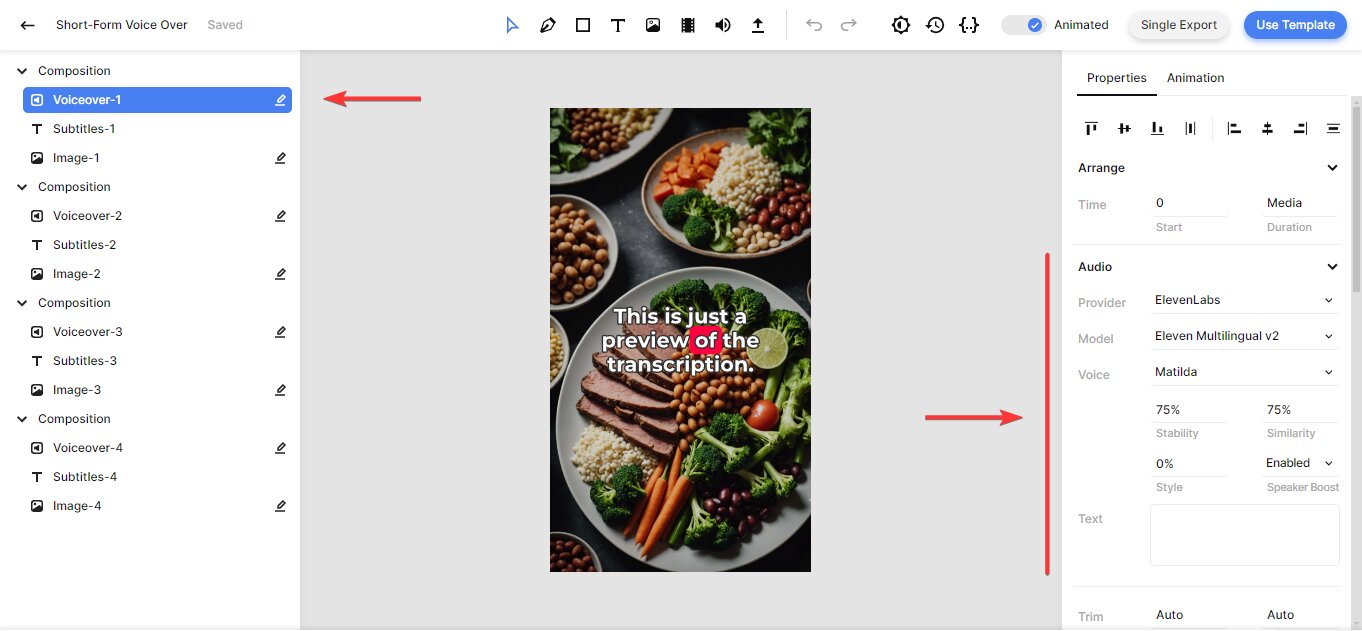
For the Voice, Matilda is the default; a premade voice from ElevenLabs. But what if you want a custom voice? To do this, click on Matilda, scroll up, and select Custom Voice. Paste the voice ID from your ElevenLabs dashboard, and click OK:
You can also adjust the Stability, Similarity, Style, and Speaker Boost parameters. These AI settings allow you to fine-tune the voiceover generated by ElevenLabs. For example, the Stability parameter controls the amount of emotion and randomness in the voice. I recommend keeping the default settings unless there's a specific reason to change them; they are perfect for most purposes. For more details, you can refer to ElevenLabs' Voice Settings documentation.
To complete the template setup, let's look at the subtitle elements next.
In the left side panel, select the Subtitles-1 element. Then, in the properties panel on the right, scroll down to the Transcription property. Here you can customize the subtitles. You'll see that the Source is set to the Voiceover-1 element. This tells Creatomate to generate subtitles based on the voice over.
Last but not least, you can customize the appearance of the subtitles using the Style, Color, Fill, and Stroke properties.
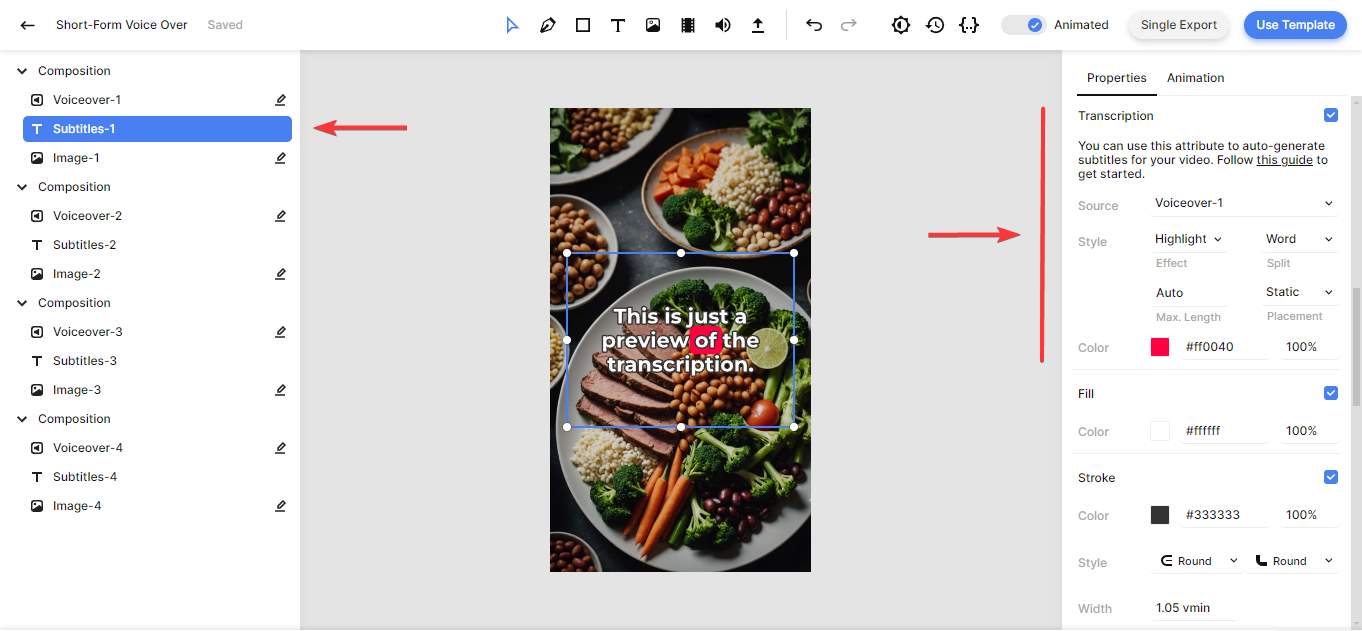
There's a lot of flexibility in the editor when it comes to creating your own video templates. Let's not go into too much detail here, but you should definitely play around with the editor after completing this tutorial. But for now, let's move on to the last step of the tutorial, where we'll use the API to generate the actual voiceover video.
If you're wondering how to use generative AI in your voiceover video, it's like the ElevenLabs integration, but instead of ElevenLabs, you connect OpenAI or Stability AI. Then, select an image element and change the Provider from "Uploaded File" to OpenAI. This lets you provide a text-to-image prompt instead of a URL. You can find out more about using AI in your video templates in the tutorial below. Even though the instructions refer to Zapier.com, the steps are the same when using a simple API request:
👉 How to use AI to Automate Videos for Shorts, Stories, and Reels
3. Call the REST API to generate the voiceover video
With ElevenLabs and a video template set up, all that's left is calling Creatomate's API. The API is accessible using a simple REST interface. So you don't have to install any software or libraries; just send a request over HTTP.
Two things are needed for this API request; the API key and the template ID. You can find them both under Use Template at the top right:
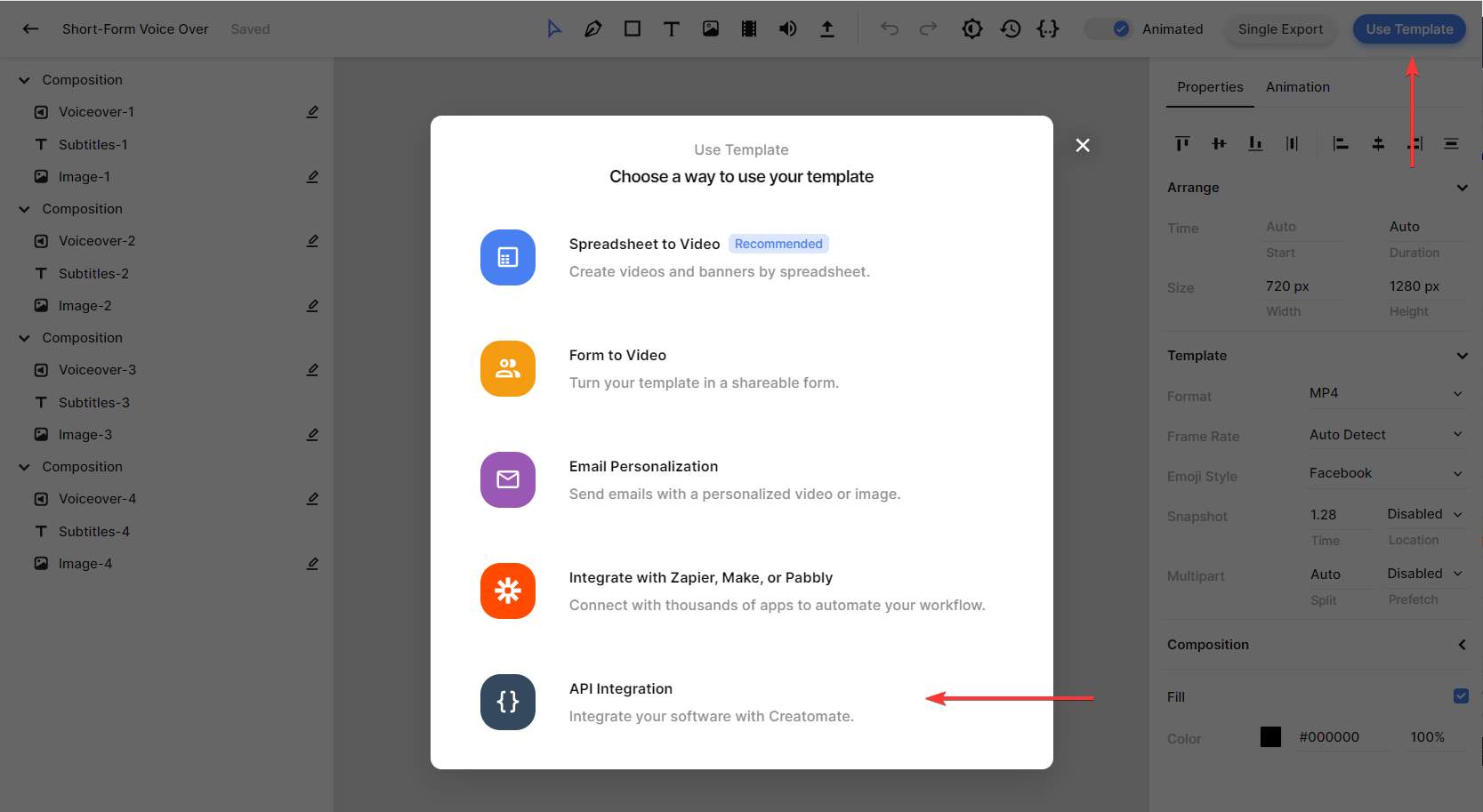
Then go to API Integration. You'll find instructions there:
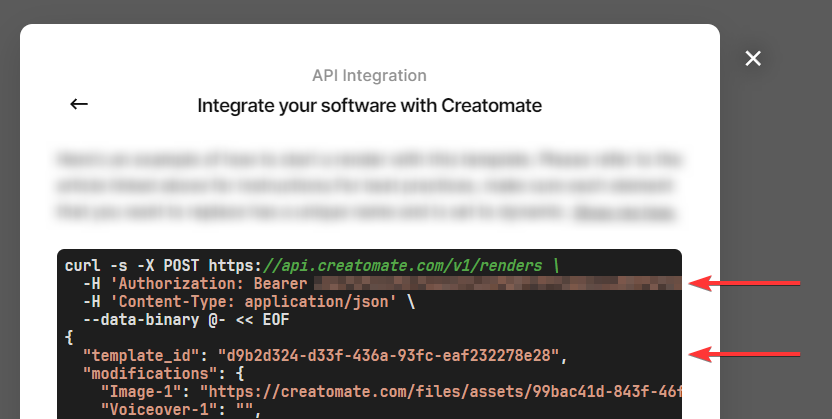
Let's look at the API request more closely. As you can see, you'll need to make a POST request to the "https://api.creatomate.com/v1/renders" endpoint. You'll need to specify an API key, a template ID, and the "modifications" parameter.
The modifications parameter lets us specify what changes we want to make to the template before it's rendered. Here, we'll change the image elements (Image-1, Image-2, etc.) and the voiceover elements (Voiceover-1, Voiceover-2, etc.). For the images, we'll pass an URL, and for the voiceovers, we'll pass a text sentence:
1curl -s -X POST https://api.creatomate.com/v1/renders \
2 -H 'Authorization: Bearer [Your-API-Key]' \
3 -H 'Content-Type: application/json' \
4 --data-binary @- << EOF
5{
6 "template_id": "[Your-Template-ID]",
7 "modifications": {
8 "Image-1": "https://cdn.creatomate.com/demo/better-sleep-1.jpg",
9 "Voiceover-1": "The 3 Best Tips for Better Sleep",
10 "Image-2": "https://cdn.creatomate.com/demo/better-sleep-2.jpg",
11 "Voiceover-2": "Create a Relaxing Bedtime Routine: Wind down before bed with activities like reading, taking a warm bath, or practicing relaxation techniques.",
12 "Image-3": "https://cdn.creatomate.com/demo/better-sleep-3.jpg",
13 "Voiceover-3": "Maintain a Consistent Sleep Schedule: Go to bed and wake up at the same time every day, even on weekends, to regulate your body's internal clock.",
14 "Image-4": "https://cdn.creatomate.com/demo/better-sleep-4.jpg",
15 "Voiceover-4": "Exercise Regularly: Stay active during the day, but avoid vigorous exercise close to bedtime for better sleep quality."
16 }
17}
18EOFFor this example, we'll use the cURL command-line program to make the API request. But this request can be made through any API client, such as Postman or Insomnia. Or you can write a script to do the request.
If you want to integrate the API into your script or app, take a look at these examples for Node.js, PHP, and Python:
👉 How to Create Voiceover Videos using Node.js
👉 How to Create Voiceover Videos using PHP
👉 How to Create Voiceover Videos using Python
As soon as you call the API endpoint, Creatomate gets to work. To begin with, it inserts the "modifications" data into the template. It then calls all third-party APIs required for the template, such as ElevenLabs, OpenAI, or Stability AI. For this template, that would only be ElevenLabs, but if you configured your template to generate images using DALL·E or Stable Diffusion, it will call those APIs as well. As soon as that is complete, Creatomate compiles it all together into a video.
Immediately after calling the endpoint, we'll receive a JSON response confirming Creatomate has accepted the request:
1{
2 "id": "a862048b-d0dc-4029-a4ef-e172e8ded827",
3 "status": "planned",
4 "url": "https://cdn.creatomate.com/renders/a862048b-d0dc-4029-a4ef-e172e8ded827.mp4",
5 "snapshot_url": "https://cdn.creatomate.com/snapshots/a862048b-d0dc-4029-a4ef-e172e8ded827.jpg",
6 ...
7}The response shows that Creatomate successfully started a new job to generate the voiceover video. You can see that the "status" is set to "planned", indicating that the generation job is in progress. The process may take a few minutes, depending on the complexity of the template. It is now time to wait for the video to finish.
There are two ways in which you can await the video. In the first approach, the status of the video is obtained by performing a separate GET call. The second, and the recommended way, is by using a webhook. This essentially means that Creatomate is capable of making a reverse API call to your application whenever the video is ready for use.
For this example, we'll just wait a minute or two. Grab a cup of coffee and sit back for a bit. Then visit the URL you got from the API request. If the URL returns "Not Found", the video has not been completed. Wait a little longer and try again.
When it's done, the URL will return the finished video:
Tip: Your requests are listed under the API Log page in Creatomate. This shows you the 50 most recent videos. See if any issues are listed there if the request did not succeed.
Next steps for creating voiceover videos
At its most basic level, that's all there is to it! Throughout this tutorial, I have provided a step-by-step walkthrough on how to create a voiceover video with subtitles using Creatomate and ElevenLabs. In order to keep things as simple as possible, we've generated a simple video with a few images and voiceovers.
But it doesn't end there. There's so much more you can do with video automation. For instance, we barely mentioned Creatomate's integration with OpenAI. In fact, you can create entire videos from scratch by combining DALL·E, ChatGPT, and ElevenLabs.
We haven't looked at Creatomate's template editor very closely either. Even if you don't want to use AI, Creatomate's video editor has plenty of options for setting up automation templates. See our blog page for more step-by-step tutorials.